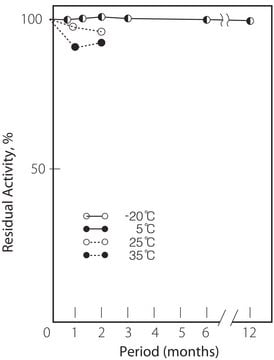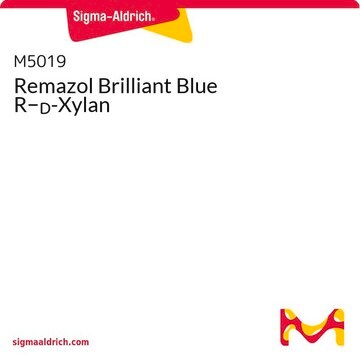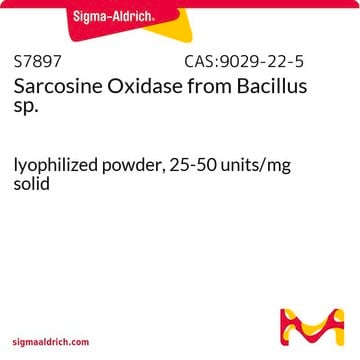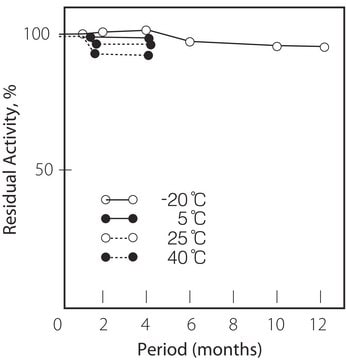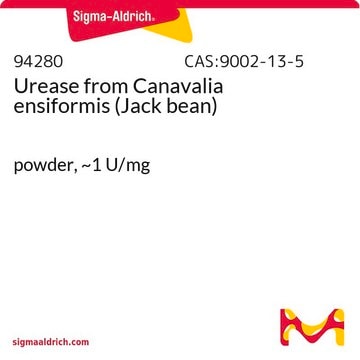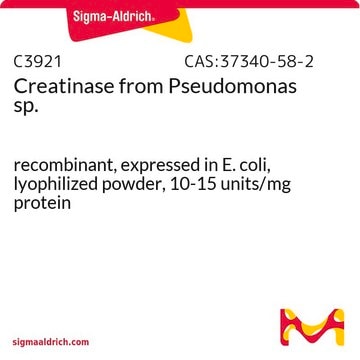₩1,554,371
예상 입고일2025년 3월 31일세부사항
추천 제품
양식
lyophilized powder
특이 활성도
≥25 units/mg protein
분자량
~260 kDa
구성
Protein, ≥15% biuret
저장 온도
−20°C
관련 카테고리
애플리케이션
Creatinine Deiminase microbial has been used:
- to immobilize aminosilylated glass beads based biosensor for ammonia/ammonium and creatinine detection in urine[1]
- in creating creatinine-sensing membrane for biophysical studies[2]
- to investigate the bioelectronic tongue for the simultaneous determination of urea, creatinine and alkaline ions in clinical samples[3]
Creatinine deiminase has been used in a study to assess the application of a creatinine-sensitive biosensor for hemodialysis control. Creatinine deiminase has also been used in a study to investigate the bioelectronic tongue for the simultaneous determination of urea, creatinine and alkaline ions in clinical samples.
생화학적/생리학적 작용
Creatinine deiminase catalyzes the hydrolysis of creatinine to methylhydantoine and ammonia.[1]
물리적 특성
Isoelectric point : 4.4
Michaelis constant : 3.5 x 10‾3M (Creatinine)
Structure : 6 subunits per mol of enzyme
Inhibitors : Ag+,Hg++, o-phenanthroline,monoiodoacetate
Optimum pH : 8.5 – 9.5
Optimum temperature : 65 – 75°C
pH Stability : pH 7.0 – 11.0 (30°C, 20hr)
Thermal stability : Below 65°C (pH 7.5, 1hr)
Michaelis constant : 3.5 x 10‾3M (Creatinine)
Structure : 6 subunits per mol of enzyme
Inhibitors : Ag+,Hg++, o-phenanthroline,monoiodoacetate
Optimum pH : 8.5 – 9.5
Optimum temperature : 65 – 75°C
pH Stability : pH 7.0 – 11.0 (30°C, 20hr)
Thermal stability : Below 65°C (pH 7.5, 1hr)
단위 정의
One unit will hydrolyze 1.0 μmole of creatinine to N-methylhydantoin and NH3 per min at pH 7.5 at 37 °C in a coupled system with L-glutamic dehydrogenase.
물리적 형태
Lyophilized powder containing mannitol as stabilizer
Storage Class Code
11 - Combustible Solids
WGK
WGK 3
Flash Point (°F)
Not applicable
Flash Point (°C)
Not applicable
개인 보호 장비
Eyeshields, Gloves, type N95 (US)
Z K He et al.
Analytical biochemistry, 283(2), 166-174 (2000-07-25)
A precise and sensitive working microflow titration procedure was developed to determine creatinine and ammonia in urine samples. This procedure is based on enzymatic conversion of creatinine, gas diffusional membrane separation of the released ammonia into an acid acceptor stream
R G Washburn et al.
The Journal of antimicrobial chemotherapy, 17(5), 673-677 (1986-05-01)
Creatinine iminohydrolase (EC 3.5.4.21) quantitatively releases ammonia from flucytosine (5FC) as well as from creatinine. Using 39 sera from eight patients receiving the combination of amphotericin B with 5FC, we demonstrated that this rapid enzymatic reaction provides a valid measure
C S Rui et al.
Annals of the New York Academy of Sciences, 672, 264-271 (1992-11-30)
A flow-injection analysis biosensor system was developed for the amperometric assay of creatinine based on coupled reactions of three immobilized enzymes, using an oxygen electrode as the detection device. The ammonia produced by creatinine deiminase-catalyzed hydrolysis of creatinine was further
Manuel Gutiérrez et al.
Biosensors & bioelectronics, 23(6), 795-802 (2007-10-13)
Urea and creatinine biosensors based on urease and creatinine deiminase, respectively, covalently immobilized onto ammonium selective electrodes, were included in an array together with sensors sensitive to ammonium, potassium and sodium. Generic sensors to alkaline ions were also included. All
Hong Dinh Duong et al.
Sensors (Basel, Switzerland), 17(11) (2017-11-09)
In this study, the oxazine 170 perchlorate (O17)-ethylcellulose (EC) membrane was successfully exploited for the fabrication of creatine- and creatinine-sensing membranes. The sensing membrane exhibited a double layer of O17-EC membrane and a layer of enzyme(s) entrapped in the EC
활성 필터
자사의 과학자팀은 생명 과학, 재료 과학, 화학 합성, 크로마토그래피, 분석 및 기타 많은 영역을 포함한 모든 과학 분야에 경험이 있습니다..
고객지원팀으로 연락바랍니다.